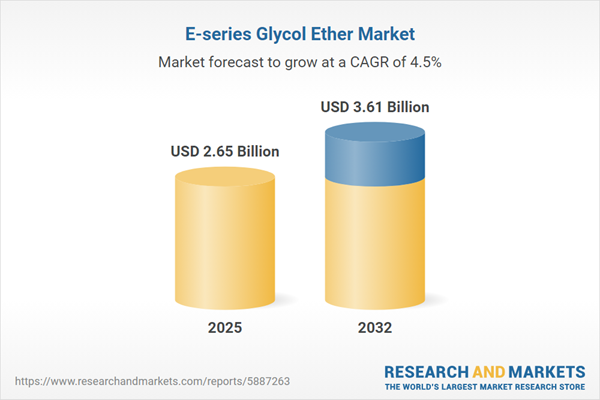Speak directly to the analyst to clarify any post sales queries you may have.
The E-series Glycol Ether market is experiencing measurable growth, driven by rising innovation, evolving regulatory demands, and increasing adoption across advanced industrial sectors. Senior leaders will find actionable insights in this comprehensive analysis, designed to support market-aligned decisions for operational and commercial strategies.
Market Snapshot: E-Series Glycol Ether Market
The E-series Glycol Ether market expanded from USD 2.54 billion in 2024 to USD 2.65 billion in 2025 and is forecast to reach USD 3.61 billion by 2032, reflecting a CAGR of 4.50%. This growth is underpinned by escalating demand from coatings, pharmaceuticals, agrochemicals, industrial cleaning, and electronics sectors, and reflects structural market shifts in supply chain strategies globally. Regulatory trends, feedstock innovations, and heightened end-user specialization are pivotal drivers shaping procurement and production approaches.
Scope & Segmentation
This report provides a detailed examination of the E-series Glycol Ether market, dissecting its structure and performance by type, application, industry, formulation, sales channel, packaging, and region:
- Type: Ethylene Glycol Monobutyl Ether (purity 95-99%, <95%, >99%); Ethylene Glycol Monoethyl Ether; Ethylene Glycol Monohexyl Ether
- Application: Agrochemicals, Industrial Cleaners (degreasing, parts cleaning), Paints and Coatings (architectural, industrial), Pharmaceuticals
- End Use Industry: Automotive, Construction, Electronics, Oil and Gas (downstream, midstream, upstream)
- Formulation: Pure Solvent, Solvent Blend (aqueous, non-aqueous)
- Sales Channel: Direct Sales, Distributors (national, regional)
- Packaging: Bulk Tanker, Drums (200L, 50L)
- Geographical Coverage: Americas (North America, Latin America), Europe, Middle East & Africa, Asia-Pacific
- Leading Producers Analyzed: The Dow Chemical Company, Eastman Chemical Company, BASF SE, Huntsman International LLC, Shell plc, Mitsubishi Chemical Holdings Corporation, LyondellBasell Industries N.V., Solvay S.A., Clariant AG
Key Takeaways for Decision-Makers
- Amphiphilic properties of E-series Glycol Ether compounds support their expanded use in both polar and nonpolar applications, allowing for high versatility in industrial and specialty solvents.
- Increasing adoption of bio-derived feedstocks is influencing the supply chain as companies seek to meet sustainability goals and reduce reliance on conventional petrochemical sources.
- Regulatory tightening, particularly on volatile organic compounds, is accelerating industry-wide innovation toward low-emission and non-toxic solvent formulations.
- Miniaturization in semiconductor and electronics manufacturing is pushing demand for high-purity glycol ethers, especially in Asian production hubs responding to enhanced cleanliness standards.
- Market consolidation, through strategic alliances and M&A activity, is intensifying as producers position themselves to deliver scale efficiencies and integrated solutions.
- Emerging green chemistry and digital process monitoring are being leveraged by key players to differentiate offerings, optimize production, and meet evolving needs of downstream partners.
Tariff Impact: United States 2025 Revisions
Recent tariff adjustments in the United States have created new complexities for global supply chains. Exporters and domestic formulators are adapting strategies to include vendor diversification and investment in local manufacturing. These shifts emphasize the increased importance of supply chain resilience and process innovation to manage cost pressures and regulatory uncertainty.
Methodology & Data Sources
This report is built on a rigorous combination of primary data—including confidential executive interviews—and secondary research, drawn from industry journals, regulatory filings, patents, and trade databases. All findings are cross-validated using triangulation and scenario analysis for accuracy, relevance, and impartiality.
Why This Report Matters
- Enables C-suite and strategic planners to anticipate regulatory, technological, and supply chain shifts with market-contextual intelligence.
- Supports tactical investment by mapping product, formulation, and channel segmentation linked to real-time end-user demand trends.
- Highlights the competitive advantages of digital integration and sustainability leadership in advancing market share.
Conclusion
The E-series Glycol Ether market is at a pivotal transforming phase, shaped by regulation, innovation, and supply chain evolution. This analysis equips senior decision-makers to act on emerging opportunities and build robust, future-ready strategies in a dynamic global landscape.
Additional Product Information:
- Purchase of this report includes 1 year online access with quarterly updates.
- This report can be updated on request. Please contact our Customer Experience team using the Ask a Question widget on our website.
Table of Contents
3. Executive Summary
4. Market Overview
7. Cumulative Impact of Artificial Intelligence 2025
Companies Mentioned
The companies profiled in this E-series Glycol Ether market report include:- The Dow Chemical Company
- Eastman Chemical Company
- BASF SE
- Huntsman International LLC
- Shell plc
- Mitsubishi Chemical Holdings Corporation
- LyondellBasell Industries N.V.
- Solvay S.A.
- Clariant AG
Table Information
| Report Attribute | Details |
|---|---|
| No. of Pages | 190 |
| Published | October 2025 |
| Forecast Period | 2025 - 2032 |
| Estimated Market Value ( USD | $ 2.65 Billion |
| Forecasted Market Value ( USD | $ 3.61 Billion |
| Compound Annual Growth Rate | 4.5% |
| Regions Covered | Global |
| No. of Companies Mentioned | 10 |









